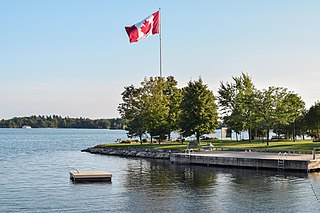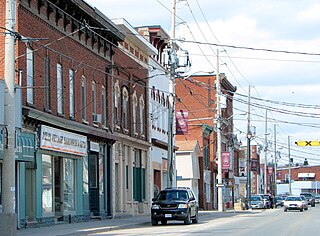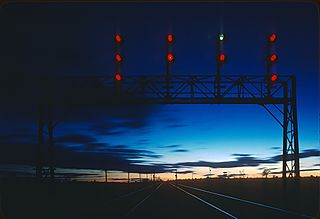
Smiths Falls is a town in Eastern Ontario, Canada, 72 kilometres (45 mi) southwest of Ottawa. As of the 2021 census it has a population of 9,254. It is in the Census division for Lanark County, but is separated from the county. The Rideau Canal waterway passes through the town, with four separate locks in three locations and a combined lift of over 15 metres (49.2 ft).

Gananoque is a town in the Leeds and Grenville area of Ontario, Canada. The town had a population of 5,383 year-round residents in the 2021 Canadian Census, as well as summer residents sometimes referred to as "Islanders" because of the Thousand Islands in the Saint Lawrence River, Gananoque's most important tourist attraction. The Gananoque River flows through the town and the St. Lawrence River serves as the southern boundary of the town.
King's Highway 33, commonly referred to as Highway 33 or Loyalist Parkway, is a provincially maintained highway in the Canadian province of Ontario. The route begins at Highway 62 in Bloomfield and travels east to the Collins Bay Road junction at Collins Bay in the city of Kingston, a distance of 60.9 kilometres (37.8 mi). The highway continues farther east into Kingston as Bath Road, ending at the former Highway 2, now Princess Street. Highway 33 is divided into two sections by the Bay of Quinte. The Glenora Ferry service crosses between the two sections just east of Picton, transporting vehicles and pedestrians for free throughout the year.

Tweed is a municipality located in central-eastern Ontario, Canada, in Hastings County.
Area codes 613, 343, and 753 are telephone area codes in the North American Numbering Plan (NANP) for Ottawa and surrounding Eastern Ontario, Canada. Area code 613 is one of the 86 original North American area codes assigned in October 1947. Area code 343 was assigned to the numbering plan area in an overlay plan activated on May 17, 2010. Area code 753 was assigned as an additional overlay code for the numbering plan area, activated on March 26, 2022.

Tweed, Ontario is a community on Stoco Lake and the only urban centre in the Municipality of Tweed in Hastings County, central-eastern Ontario, Canada. Tweed has a population of 1,701 according to the 2016 Canada Census. The principal thoroughfare through Tweed is Highway 37.

The Kingston railway station is an inter-city passenger rail station in Cataraqui, Kingston, Ontario, Canada. It is served by Via Rail trains running from Toronto to Ottawa or Montreal, along the Corridor route. It is located on John Counter Boulevard, northeast of Princess Street and north-west of downtown Kingston.

Napanee railway station in Napanee, Ontario, Canada is served by Via Rail trains running from Toronto to Ottawa and Montreal. The 1856 limestone railway station is an unstaffed but heated shelter with telephones and washrooms, which opens at least half an hour before a train arrives. The shelter and platform are wheelchair-accessible.
Limestone District School Board is an English public district school board encompassing a region that includes the City of Kingston and the counties of Frontenac and Lennox and Addington in Eastern Ontario, Canada. The board was founded in a 1998 provincial reorganization of all Ontario school boards. It is an amalgamation of the former Frontenac County and Lennox and Addington County Boards of Education. The board's Chair for 2020-2021 is Suzanne Ruttan. The Vice-Chair is Tom Gingrich.

The Empire B Junior C Hockey League is a former Junior "C" ice hockey league in Ontario, Canada, sanctioned by the Ontario Hockey Association. The league was merged into the Provincial Junior Hockey League as the Tod Division in the summer of 2016.

Deseronto is a town in the Canadian province of Ontario, in Hastings County, located at the mouth of the Napanee River on the shore of the Bay of Quinte, on the northern side of Lake Ontario.

The Kingston and Pembroke Railway (K&P) was a Canadian railway that operated in eastern Ontario. The railway was seen as a business opportunity which would support the lumber and mining industries, as well as the agricultural economy in eastern Ontario.

The Thousand Islands Railway was an 8 km (5.0 mi) long railway running from the town of Gananoque north to the Grand Trunk Railway Toronto-Montreal mainline, just south of present-day Cheeseborough. The service ran for 111 years between 1884 and 1995. The rails were removed in October 1997.

Canadian National Railway's Kingston Subdivision, or Kingston Sub for short, is a major railway line connecting Toronto with Montreal that carries the majority of CN traffic between these points. The line was originally the main trunk for the Grand Trunk Railway between these cities, although there has been some realignment of the route between these cities. The majority of the Kingston Sub runs close to the northern bank of Lake Ontario and the Saint Lawrence River.

The Central Ontario Railway (COR) was a former railway that ran north from Trenton, Ontario to service a number of towns, mines, and sawmills. Originally formed as the Prince Edward County Railway in 1879, it ran between Picton and Trenton, where it connected with the Grand Trunk Railway that ran between Montreal and Toronto. After being purchased by a group of investors and receiving a new charter to build northward, the company was renamed the Central Ontario Railway in 1882, and it started building towards the gold fields at Eldorado and newly discovered iron fields in Coe Hill.

The Railway Museum of Eastern Ontario, a rail museum in a former CNoR station, stands on the abandoned right-of-way of a Canadian Northern Railway line which once led southwest toward Napanee. Established 1985 as the Smiths Falls Railway Museum, the RMEO works to preserve the 1913 Canadian Northern (CNoR) station and a collection of historic rolling stock, equipment and railway memorabilia.

The Memory Junction Railway Museum preserved a collection of railway memorabilia in southeastern Ontario. It closed in 2017 and its collections were auctioned in 2021. It was located in the former Grand Trunk Railway station of Brighton, Ontario, which opened in 1857 and served intercity rail passengers until the 1960s.

The Cataraqui Trail is a 104-km Rails-to-Trails multi-use linear recreational trail in Eastern Ontario, Canada. The route passes by farmland, woods, lakes, and wetlands. The trail begins southwest of Smiths Falls, at a parking lot south of Ontario Highway 15 designated as kilometre zero.

Edward Wilkes Rathbun was an American-born entrepreneur and political figure in Ontario, Canada.

















